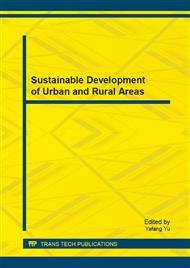p.817
p.821
p.825
p.829
p.833
p.837
p.841
p.845
p.851
Heavy Metals Removal Property of Major Afforested Plants in Xiangtan Manganese Mine Area, Central-South China
Abstract:
The aim is to study the major afforested plants in heavy metal pollution area, so as to study the mechanism of heavy metals absorption of plants. Through surveyed dominant tree and analyzed heavy metal content in different parts of its body, and analysed heavy metal content in different species of main shrubs and herbs. The results show that: (1)The dominant tree is Koelreuteria paniculata which can adapt to different heavy metals pollution. Through its own physiological regulation such as stores preferentially in the vacuole of leaf epidermal cells, accumulates in apoplast of the adaxial epidermal cell wall and combines organic acid or a variety of peptides to form chelates in leaves, so as to degrade heavy metal. Main heavy metal (Mn) content in its body show that: leaves> bark> roots> branches> stems. (2) shrubs and herbs have different heavy metals absorption capacity, which show that: Canna warscewiezii>Thalia dealbata>Boehmeria>Pontederia cordata>Typha orientalis>Softstem bulrush>Iris germanica>Nerium oleander>Phragmites australis.
Info:
Periodical:
Pages:
833-836
Citation:
Online since:
January 2014
Authors:
Keywords:
Price:
Сopyright:
© 2014 Trans Tech Publications Ltd. All Rights Reserved
Share:
Citation:


